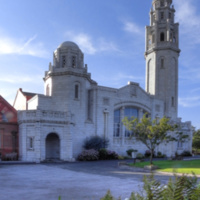Description
The Fairhaven Congregational Church was opened in 1912, perhaps the peak period for Congregationalism in Britain. Known locally as ‘the White Church’ for good reason, its tall tower and three domes are built in a striking Byzantine style. But, as the historian J.C.G Binfield put it, ‘The church’s exterior was merely a shell for the convenience of the fellowship garnered within for the glory and worship of God, designed to arrest the attention but nothing more’, while the interior was ‘dignified but congregational, light, spacious, eschewing such tricks or mysteries as the exterior might suggest’ – apart from the ‘exception’ of the extensive stained-glass windows. Luke Walmsley, a retired Blackburn art dealer and one of the founder members of the White Church, had come up with the idea of a ‘stately composition in stained glass’ that would become ‘a reverent pageant, a crowning of Liberty and a holy offering of thanksgiving and praise.’
In practice, this meant a series of windows – 58 altogether – that portrayed worthy figures and events that told the story of the pursuit of religious liberty. John Robinson, pastor of the Separatists in England and Holland, features in one window. Another, and one of the largest filling an upper space, depicts the embarkation of the Pilgrim Fathers. In a vibrant scene, men (in stereotypical Puritan hats), women and children clamour towards a ship – ‘Mayflower’ can just be seen on a pennant.
In 1972, as the Church adapted to dwindling congregations nationally, it became part of the United Reform Church (the union of Congregational and Presbyterian churches).
Do you have any photos of this beautiful stained glass window? We'd love to hear from you if so!
Source
‘Biographical’, Sheffield Daily Telegraph (16th May 1912), 4.
J.C.G. Binfield, ‘The White Church, Fairhaven: an artist trader’s Protestant Byzantium’, Transactions of the Historic Society of Lancashire and Cheshire, 142 (1993).

